Gelatin-Based Zinc-Loaded Hydrogels Constructed with the Assistance of Sodium Alginate and Zinc Sulfate Solution Soaking Method
Abstract
1. Introduction
2. Materials and Methods
2.1. Materials and Chemicals
2.2. Preparation of Gelatin-Sodium Alginate (GE-ALG) Hydrogels
2.3. Preparation of Zinc-Loaded Hydrogels
2.4. Zn2+ Loading Capacity (LC)
2.5. Texture Profile Analysis (TPA)
2.6. Rheological Properties
2.7. Melting Temperature and Gelling Temperature
2.8. pH Sensitivity
2.9. Microstructure
2.10. Fourier Transform Infrared Spectra (FTIR)
2.11. X-Ray Diffraction (XRD)
2.12. X-Ray Photoelectron Spectroscopy (XPS)
2.13. Statistical Analysis
3. Results
3.1. Analysis of Zn2+ LC
3.2. Analysis of Texture Profile
3.3. Analysis of Rheological Properties
3.4. Analysis of Melting Temperature and Gelling Temperature
3.5. Analysis of pH Sensitivity
3.6. Analysis of Microscopic Morphology
3.7. Analysis of FTIR Spectrum
3.8. Analysis of XRD Spectroscopy
3.9. Analysis of XPS
4. Conclusions
Supplementary Materials
Author Contributions
Funding
Institutional Review Board Statement
Informed Consent Statement
Data Availability Statement
Conflicts of Interest
References
- Xie, N.; Huang, J.; Li, B.; Cheng, J.; Wang, Z.; Yin, J.; Yan, X. Affinity purification and characterisation of zinc chelating peptides from rapeseed protein hydrolysates: Possible contribution of characteristic amino acid residues. Food Chem. 2015, 173, 210–217. [Google Scholar] [CrossRef]
- Duan, M.; Li, T.; Liu, B.; Yin, S.; Zang, J.; Lv, C.; Zhao, G.; Zhang, T. Zinc nutrition and dietary zinc supplements. Crit. Rev. Food Sci. Nutr. 2021, 63, 1277–1292. [Google Scholar] [CrossRef]
- Wang, M.; Phadke, M.; Packard, D.; Yadav, D.; Gorelick, F. Zinc: Roles in pancreatic physiology and disease. Pancreatology 2020, 20, 1413–1420. [Google Scholar] [CrossRef]
- Qiao, F.; Yu, X.; Tie, S.; Chen, Y.; Hou, S.; Tan, M. Zinc delivery system constructed from food-borne nanoparticles derived from Undaria pinnatifida. Food Funct. 2021, 12, 8626–8634. [Google Scholar] [CrossRef]
- Udechukwu, M.C.; Collins, S.A.; Udenigwe, C.C. Prospects of enhancing dietary zinc bioavailability with food-derived zinc-chelating peptides. Food Funct. 2016, 7, 4137–4144. [Google Scholar] [CrossRef] [PubMed]
- Jiang, W.; Zhai, S.; Zhu, L.; Bai, Y.; Li, J.; Li, J. Protein/polysaccharide based oral delivery system for precise targeting of polyphenols and carotenoids. Food Biosci. 2024, 62, 105311. [Google Scholar] [CrossRef]
- Irfan, J.; Hussain, M.A.; Haseeb, M.T.; Ali, A.; Farid-ul-Haq, M.; Tabassum, T.; Hussain, S.Z.; Hussain, I.; Naeem-ul-Hassan, M. A pH-sensitive, stimuli-responsive, superabsorbent, smart hydrogel from psyllium (Plantago ovata) for intelligent drug delivery. RSC Adv. 2021, 11, 19755–19767. [Google Scholar] [CrossRef] [PubMed]
- Singh, A.; Kar, A.K.; Singh, D.; Verma, R.; Shraogi, N.; Zehra, A.; Gautam, K.; Anbumani, S.; Ghosh, D.; Patnaik, S. pH-responsive eco-friendly chitosan modified cenosphere/alginate composite hydrogel beads as carrier for controlled release of imidacloprid towards sustainable pest control. Chem. Eng. J. 2022, 427, 131215. [Google Scholar] [CrossRef]
- Gang, F.; Li, R.; Dang, Z.; Meng, X.; Zhang, J.; Sun, X. High-stretchable, transparent, degradable and anti-drying gelatin hydrogel for mango preservation. LWT-Food Sci. Technol. 2025, 222, 117634. [Google Scholar] [CrossRef]
- Yang, X.; Tan, Z.; Zhao, W.; Zheng, Y.; Ling, S.; Guo, X.; Dong, X. Molecular interactions and gel network modulation in ionic polysaccharide-gelatin hydrogels for improved texture of skipjack tuna products. Food Chem. 2025, 482, 144002. [Google Scholar] [CrossRef]
- Chen, H.; Lan, X.; Guan, X.; Luo, R.; Zhang, Q.; Ren, H.; Xu, Z.; Tang, J. Comparative study on the effects of chitosan, carrageenan, and sodium alginate on the film-forming properties of fish skin gelatin. LWT Food Sci. Technol. 2024, 199, 116111. [Google Scholar] [CrossRef]
- Hao, Y.; Zhou, M.; Chen, R.; Mao, X.; Huang, W. A bioinspired hydrogel carrier with pH/redox dual responsiveness for effective protection and intestinal targeted delivery of probiotics. J. Food Eng. 2023, 359, 111695. [Google Scholar] [CrossRef]
- Qiao, S.; Chen, W.; Zheng, X.; Ma, L. Preparation of pH-sensitive alginate-based hydrogel by microfluidic technology for intestinal targeting drug delivery. Int. J. Biol. Macromol. 2024, 254, 127649. [Google Scholar] [CrossRef] [PubMed]
- Pereira, R.N.; Rodrigues, R.M.; Altinok, E.; Ramos, Ó.L.; Malcata, F.X.; Maresca, P.; Ferrari, G.; Teixeira, J.A.; Vicente, A.A. Development of iron-rich whey protein hydrogels following application of ohmic heating-effects of moderate electric fields. Food Res. Int. 2017, 99, 435–443. [Google Scholar] [CrossRef]
- Chen, H.; Wu, D.; Ma, W.; Wu, C.; Tian, Y.; Wang, S.; Du, M. Strong fish gelatin hydrogels enhanced by carrageenan and potassium sulfate. Food Hydrocoll. 2021, 119, 106841. [Google Scholar] [CrossRef]
- Yaman, M.; Kaya, G. Speciation of iron (II) and (III) by using solvent extraction and flame atomic absorption spectrometry. Anal. Chim. Acta 2005, 540, 77–81. [Google Scholar] [CrossRef]
- Xie, Y.; Zhao, K.; Peng, J.; Jiang, L.; Shu, W.; Huang, Y.; Liu, Q.; Luo, W.; Yuan, Y. Effect of β-glucan on the gelling properties of unwashed silver carp surimi gel: Insights into molecular interactions between different sources of β-glucan and myofibrillar protein. Food Res. Int. 2025, 208, 116248. [Google Scholar] [CrossRef]
- Chen, H.; Wu, D.; Ma, W.; Wu, C.; Liu, J.; Du, M. Strong fish gelatin hydrogels double crosslinked by transglutaminase and carrageenan. Food Chem. 2022, 376, 131873. [Google Scholar] [CrossRef]
- Wang, L.; Dong, Y.; Jiang, L.; Zhang, Y.; Sui, X. The Hofmeister series: Anion effect on microbial transglutaminase cross-linked soybean protein isolate hydrogels. Food Chem. 2025, 463, 141134. [Google Scholar] [CrossRef] [PubMed]
- Yan, W.; Jia, X.; Zhang, Q.; Chen, H.; Zhu, Q.; Yin, L. Interpenetrating polymer network hydrogels of soy protein isolate and sugar beet pectin as a potential carrier for probiotics. Food Hydrocoll. 2021, 113, 106453. [Google Scholar] [CrossRef]
- Xu, J.; Yan, S.; Qi, B.; Jiang, L. New insights into the cross-linking mechanism of soybean protein-based double dynamic cross-linking hydrogels for the controlled delivery of curcumin. Food Res. Int. 2025, 211, 116456. [Google Scholar] [CrossRef]
- Ding, X.; Xu, Y.; Wang, Y.; Xie, L.; Liang, S.; Li, D.; Wang, Y.; Wang, J.; Zhan, X. Carboxymethyl konjac glucomannan-chitosan complex nanogels stabilized double emulsions incorporated into alginate hydrogel beads for the encapsulation, protection and delivery of probiotics. Carbohydr. Polym. 2022, 289, 119438. [Google Scholar] [CrossRef] [PubMed]
- Hu, X.; Wang, Y.; Zhang, L.; Xu, M. Formation of self-assembled polyelectrolyte complex hydrogel derived from salecan and chitosan for sustained release of Vitamin C. Carbohydr. Polym. 2020, 234, 115920. [Google Scholar] [CrossRef]
- Zhang, X.; Miao, F.; Niu, L.; Wei, Y.; Hu, Y.; Lian, X.; Zhao, L.; Chen, W.; Huang, D. Berberine carried gelatin/sodium alginate hydrogels with antibacterial and EDTA-induced detachment performances. Int. J. Biol. Macromol. 2021, 181, 1039–1046. [Google Scholar] [CrossRef]
- Cao, G.; Zhao, L.; Ji, X.; Peng, Y.; Yu, M.; Wang, X.; Li, X.; Ran, F. “Salting out” in Hofmeister effect enhancing mechanical and electrochemical performance of Amide-based hydrogel electrolytes for flexible zinc-ion battery. Small 2023, 19, 2207610. [Google Scholar] [CrossRef] [PubMed]
- Torres, M.; Chenlo, F.; Moreira, R. Thermal reversibility of kappa/iota-hybrid carrageenan gels extracted from Mastocarpus stellatus at different ionic strengths. J. Taiwan Inst. Chem. E 2017, 71, 414–420. [Google Scholar] [CrossRef]
- Qiao, C.; Wang, X.; Zhang, J.; Yao, J. Influence of salts in the Hofmeister series on the physical gelation behavior of gelatin in aqueous solutions. Food Hydrocoll. 2021, 110, 106150. [Google Scholar] [CrossRef]
- Haug, I.J.; Draget, K.I.; Smidsrød, O. Physical behaviour of fish gelatin-κ-carrageenan mixtures. Carbohyd. Polym. 2004, 56, 11–19. [Google Scholar] [CrossRef]
- Tsai, F.H.; Kitamura, Y.; Kokawa, M. Effect of gum arabic-modified alginate on physicochemical properties, release kinetics, and storage stability of liquid-core hydrogel beads. Carbohyd. Polym. 2017, 174, 1069–1077. [Google Scholar] [CrossRef]
- Premjit, Y.; Pandey, S.; Mitra, J. Encapsulation of probiotics in freeze-dried calcium alginate and κ-carrageenan beads using definitive screening design: A comprehensive characterisation and in vitro digestion study. Int. J. Biol. Macromol. 2024, 258, 129279. [Google Scholar] [CrossRef]
- Aycan, D. Alginate/hyaluronic acid/gelatin ternary blended films as pH-sensitive drug carriers: In vitro ampicillin release and kinetic studies. Int. J. Biol. Macromol. 2024, 277, 134111. [Google Scholar] [CrossRef] [PubMed]
- He, Q.; Huang, Y.; Wang, S. Hofmeister effect-assisted one step fabrication of ductile and strong gelatin hydrogels. Adv. Funct. Mater. 2018, 28, 1705069. [Google Scholar] [CrossRef]
- Lopes, S.; Bueno, L.; De Aguiar, F.; Finkler, C. Preparation and characterization of alginate and gelatin microcapsules containing Lactobacillus rhamnosus. An. Acad. Bras. Ciênc. 2017, 89, 1601–1613. [Google Scholar] [CrossRef] [PubMed]
- Wang, M.; Zang, Y.; Hong, K.; Zhao, X.; Yu, C.; Liu, D.; An, Z.; Wang, L.; Yue, W.; Nie, G. Preparation of pH-sensitive carboxymethyl cellulose/chitosan/alginate hydrogel beads with reticulated shell structure to deliver Bacillus subtilis natto. Int. J. Biol. Macromol. 2021, 192, 684–691. [Google Scholar] [CrossRef] [PubMed]
- Sun, R.; Liu, X.; Yu, Y.; Miao, J.; Leng, K.; Gao, H. Preparation process optimization, structural characterization and in vitro digestion stability analysis of Antarctic krill (Euphausia superba) peptides-zinc chelate. Food Chem. 2021, 340, 128056. [Google Scholar] [CrossRef]
- Zhang, X.; Liu, K.; Qin, M.; Lan, W.; Wang, L.; Liang, Z.; Li, X.; Wei, Y.; Hu, Y.; Zhao, L.; et al. Abundant tannic acid modified gelatin/sodium alginate biocomposite hydrogels with high toughness, antifreezing, antioxidant and antibacterial properties. Carbohyd. Polym. 2023, 309, 120702. [Google Scholar] [CrossRef]
- Ni, F.; Luo, X.; Zhao, Z.; Yuan, J.; Song, Y.; Liu, C.; Huang, M.; Dong, L.; Xie, H.; Ren, G.; et al. Enhancing viability of Lactobacillus plantarum encapsulated by alginate-gelatin hydrogel beads during gastrointestinal digestion, storage and in the mimic beverage systems. Int. J. Biol. Macromol. 2023, 224, 94–104. [Google Scholar] [CrossRef]
- Liu, J.; Yong, H.; Liu, Y.; Qin, Y.; Kan, J.; Liu, J. Preparation and characterization of active and intelligent films based on fish gelatin and haskap berries (Lonicera caerulea L.) extract. Food Packag. Shelf Life 2019, 22, 100417. [Google Scholar] [CrossRef]
- Cieślik, A.; Shymborska, Y.; Tymetska, S.; Stetsyshyn, Y.; Bernasik, A.; Brzychczy-Włoch, M.; Drożdż, K.; Szajna, K.; Krok, F.; Budkowski, A.; et al. Cell sheet engineering platforms integrating antibacterial and thermo-responsive functionalities: Cu-nanoparticle-loaded P4VP brushes for retinal cell sheet harvesting. Chem. Eng. J. 2025, 513, 162985. [Google Scholar] [CrossRef]
- Zheng, S.; Lin, S.; Xu, Y.; Cai, X.; Wang, S. Antibacterial activity and virulence attenuation of peptides-zinc nanocomposite against Vibrio alginolyticus. Food Biosci. 2024, 61, 104770. [Google Scholar] [CrossRef]
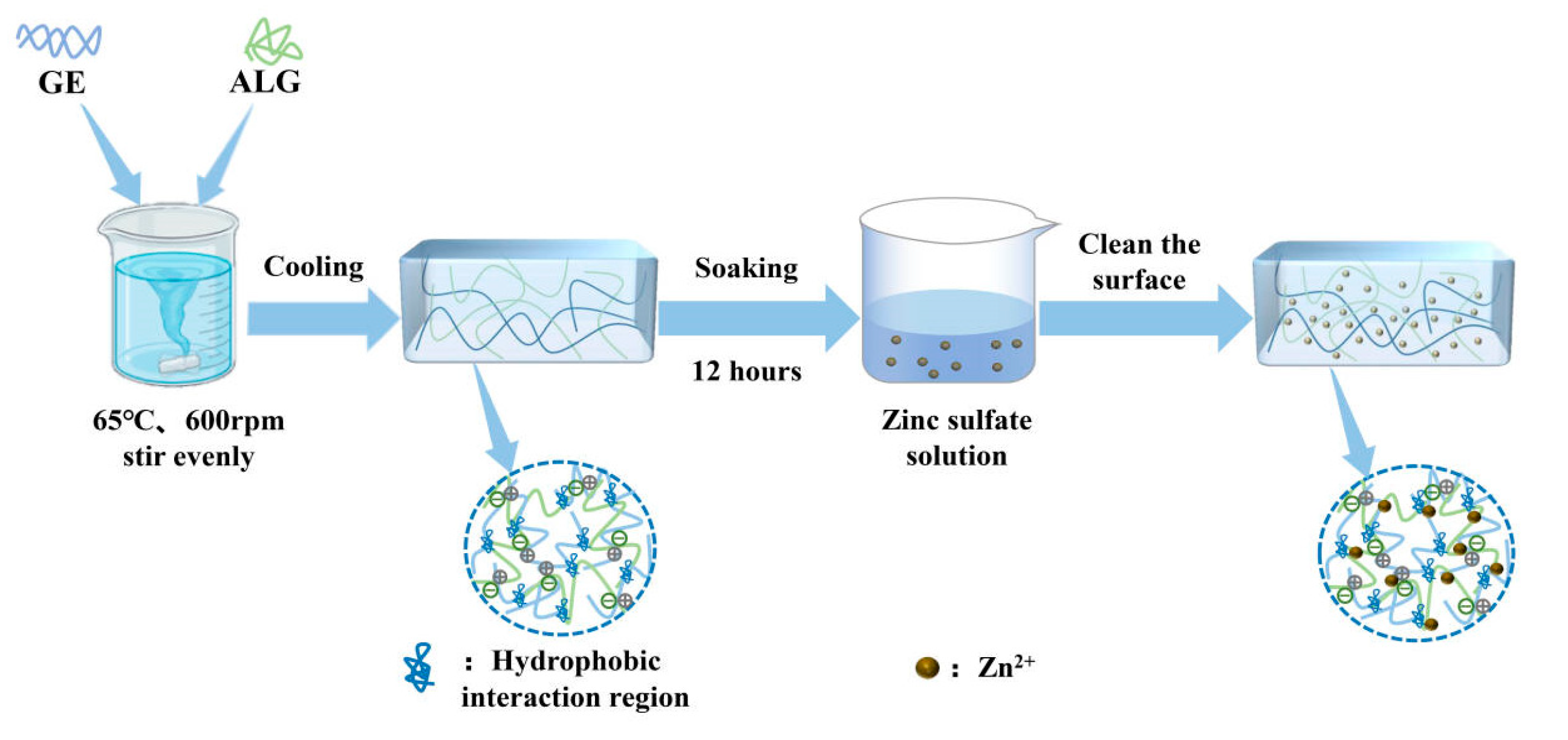
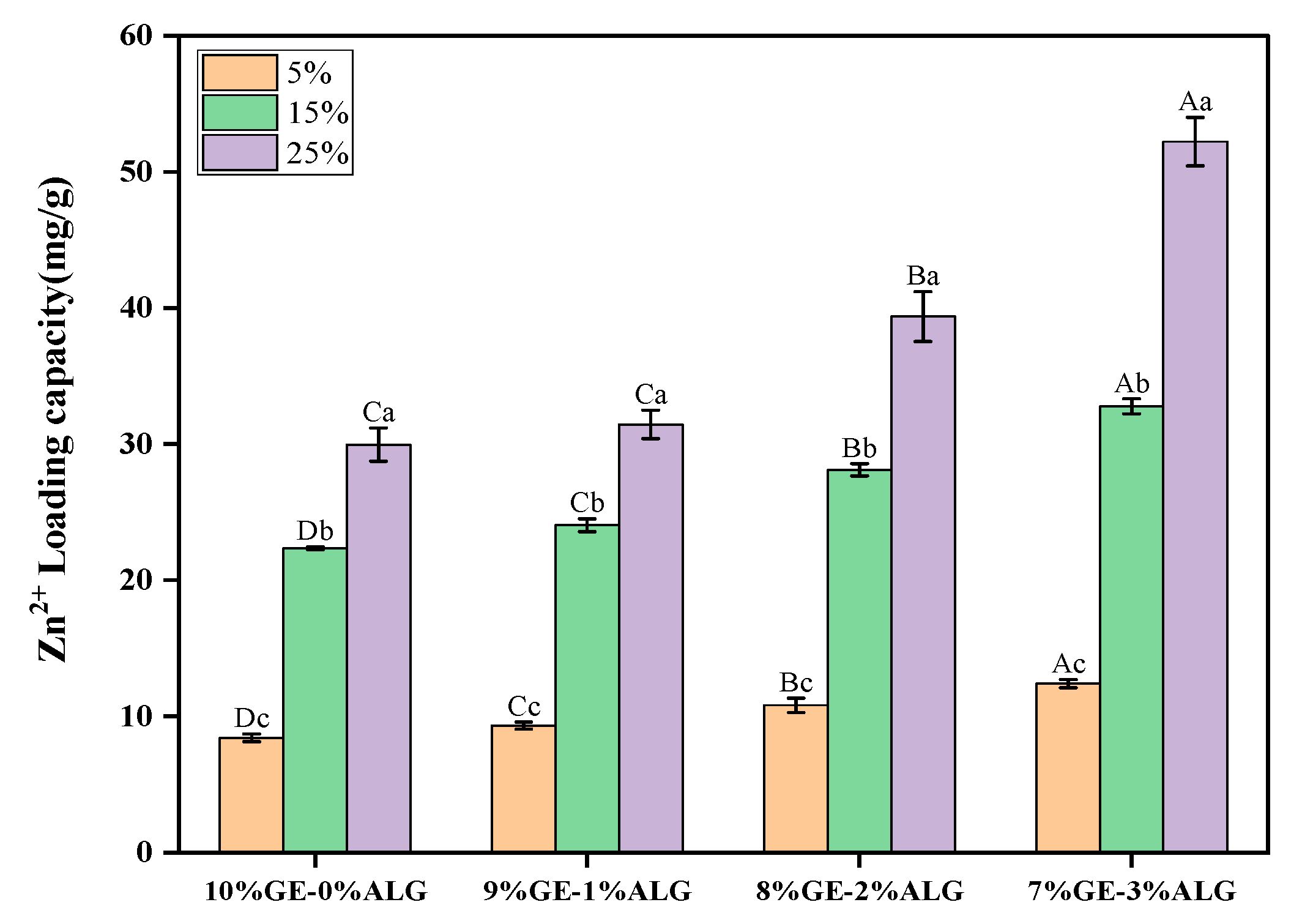
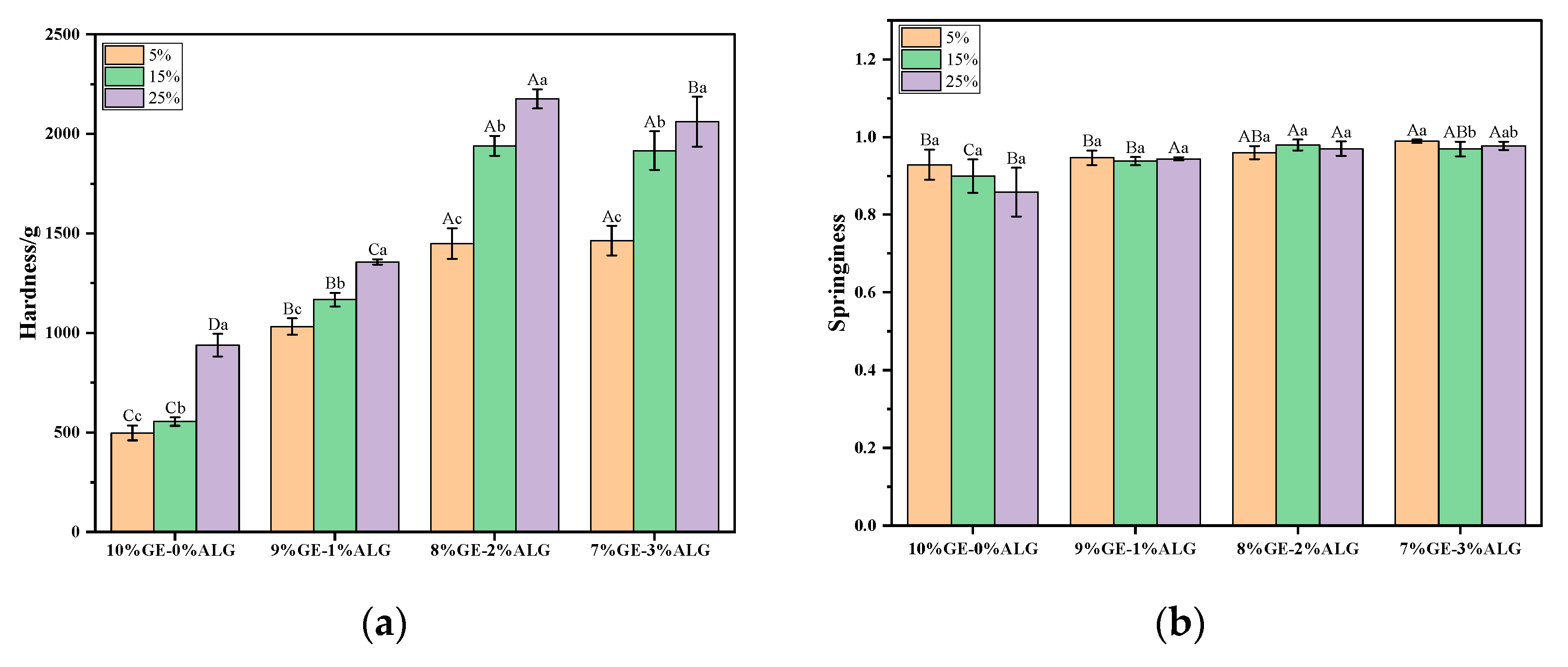
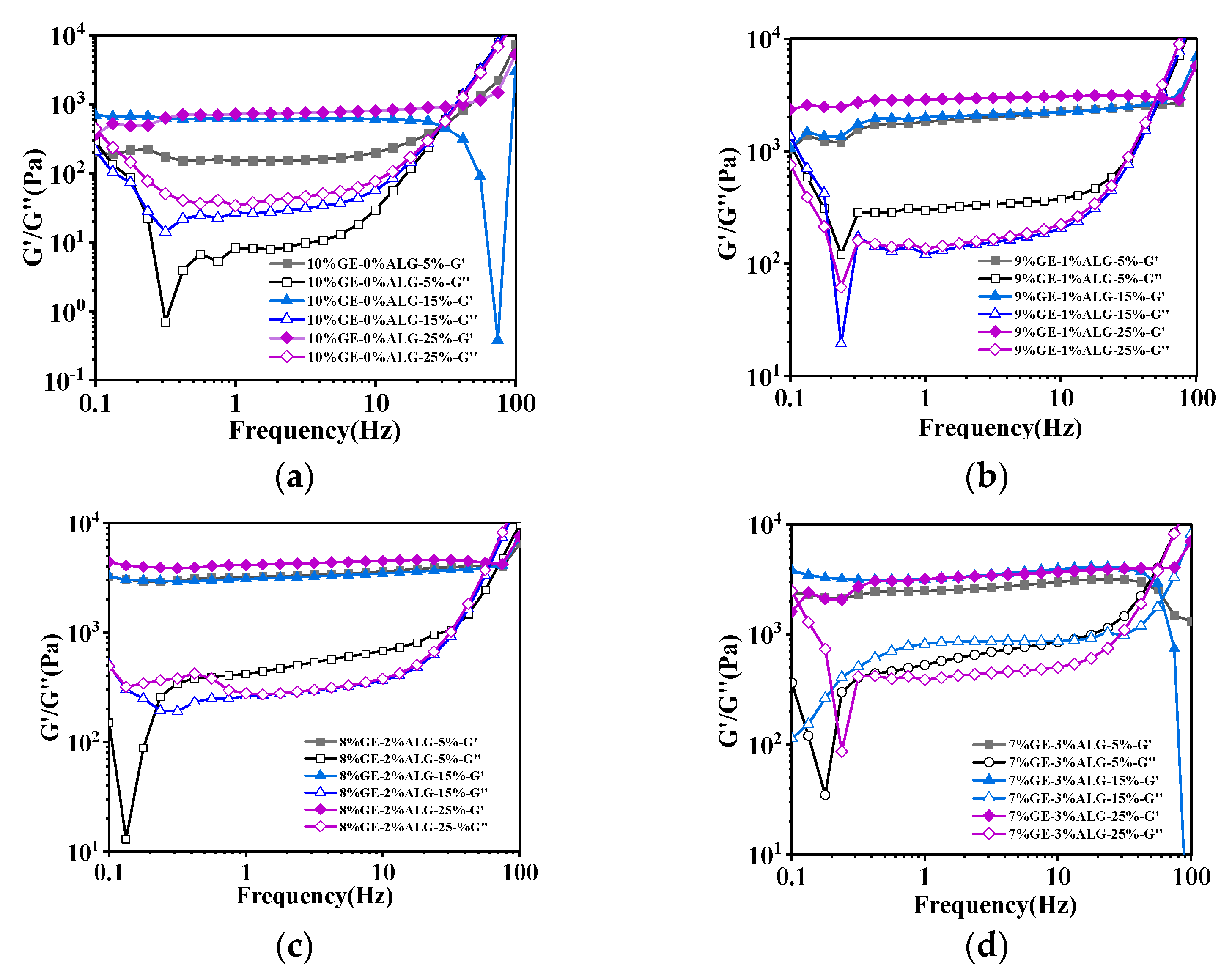
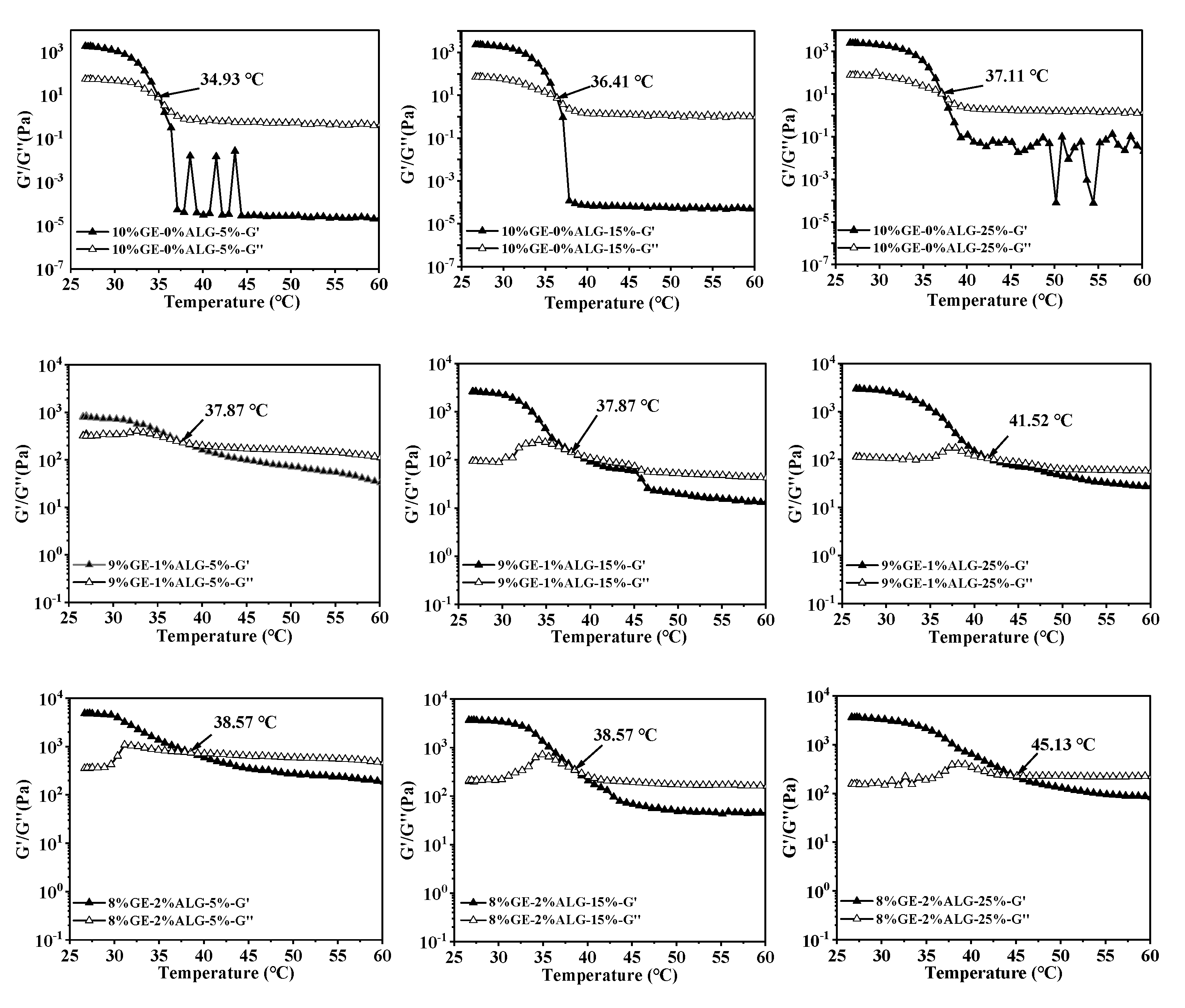

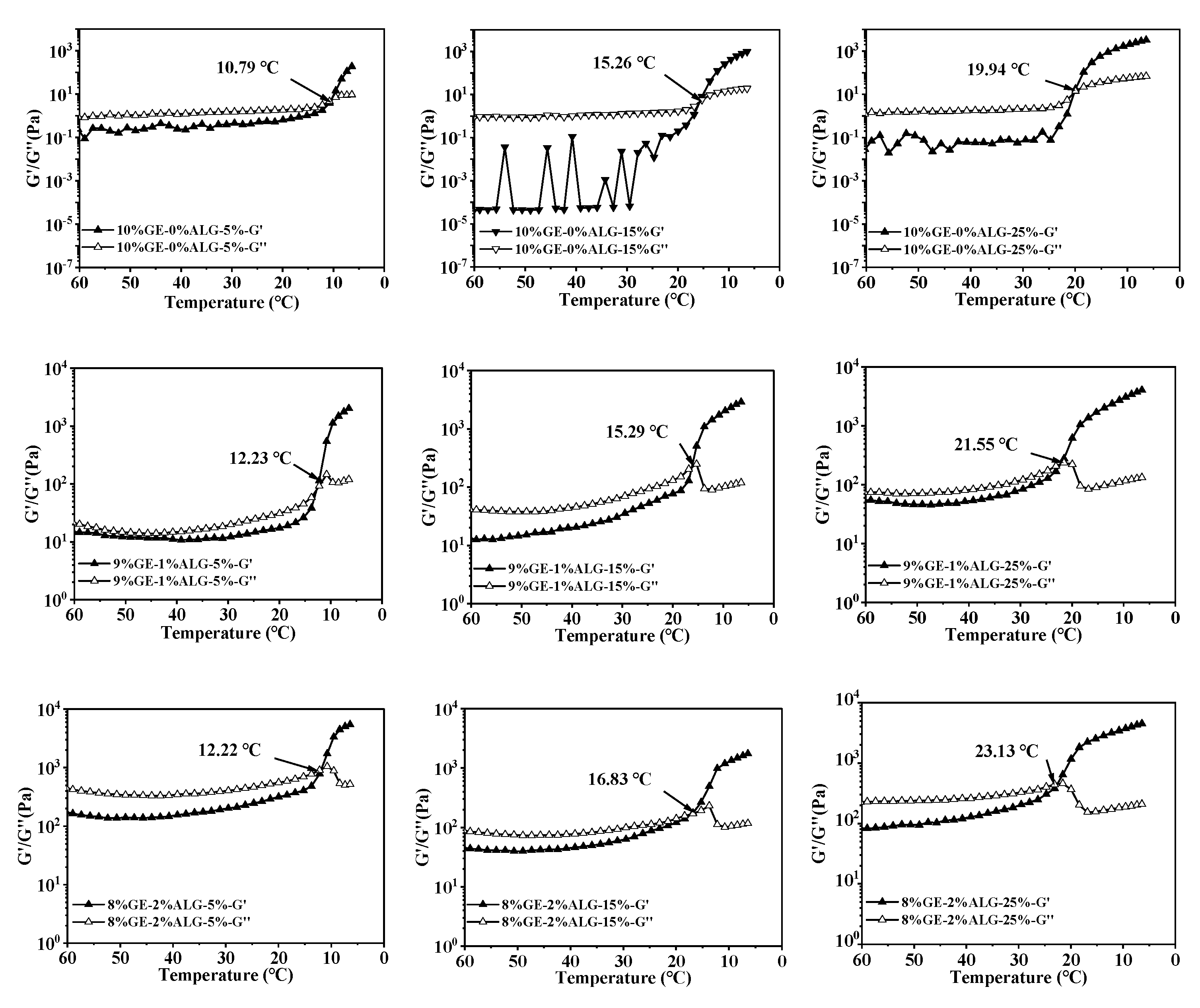

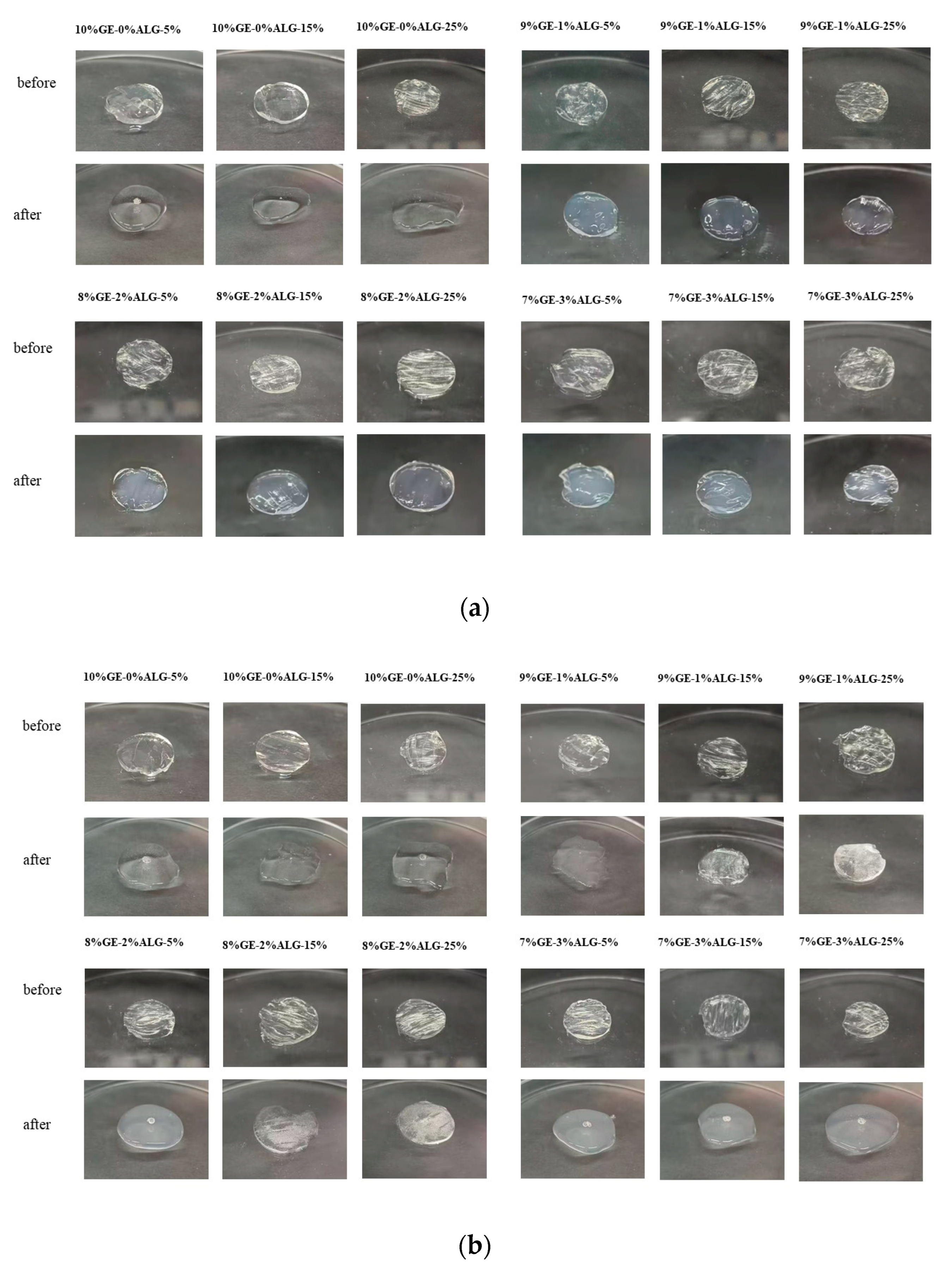
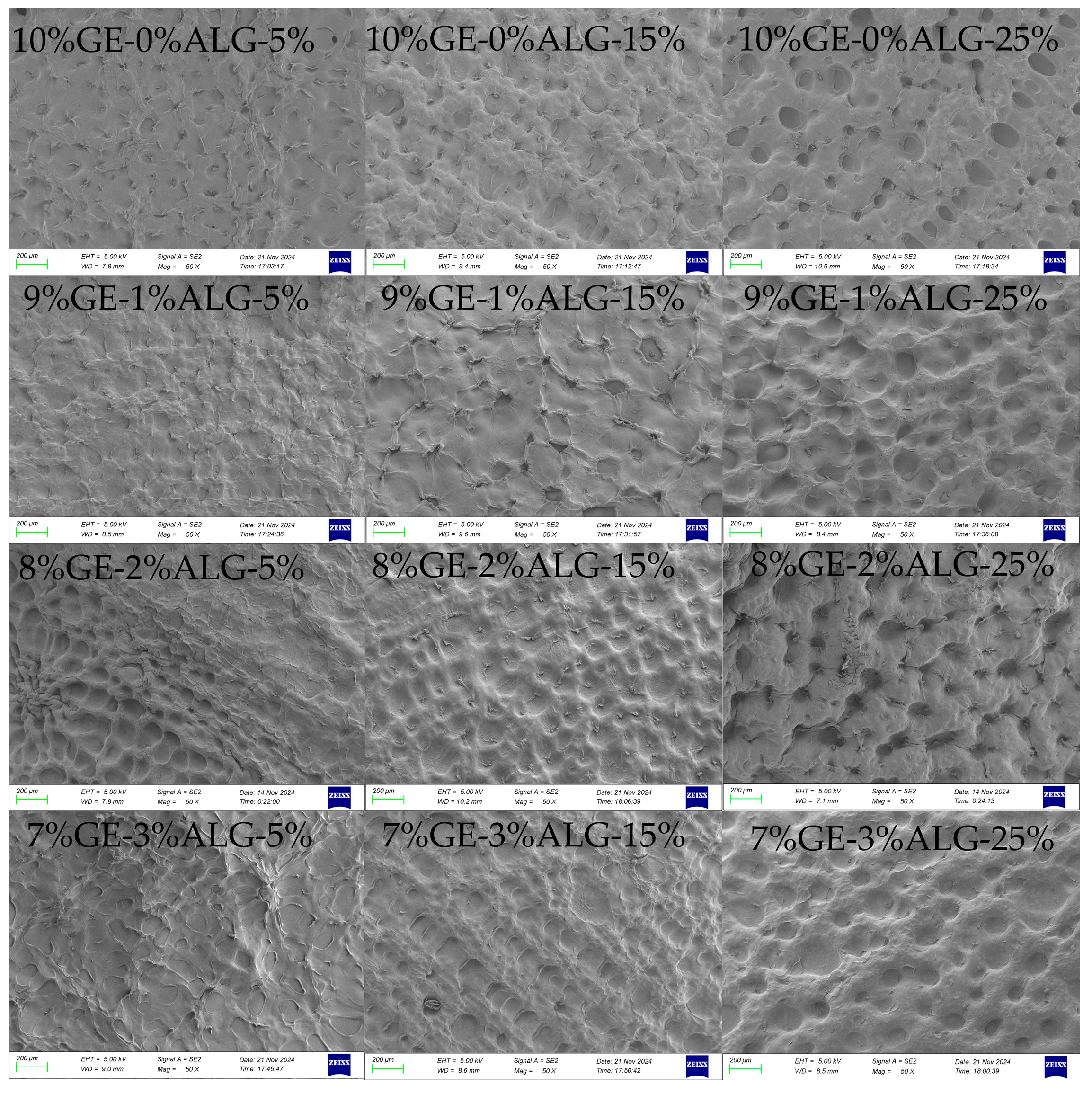
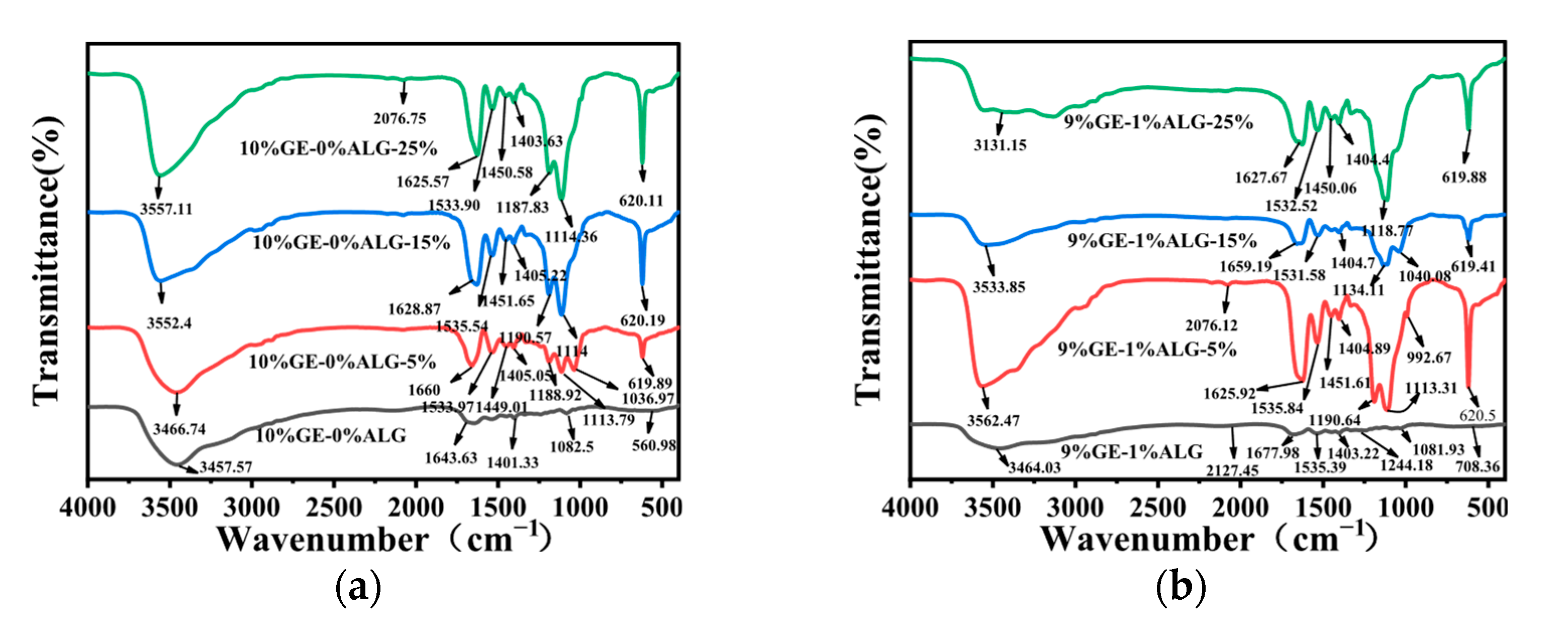
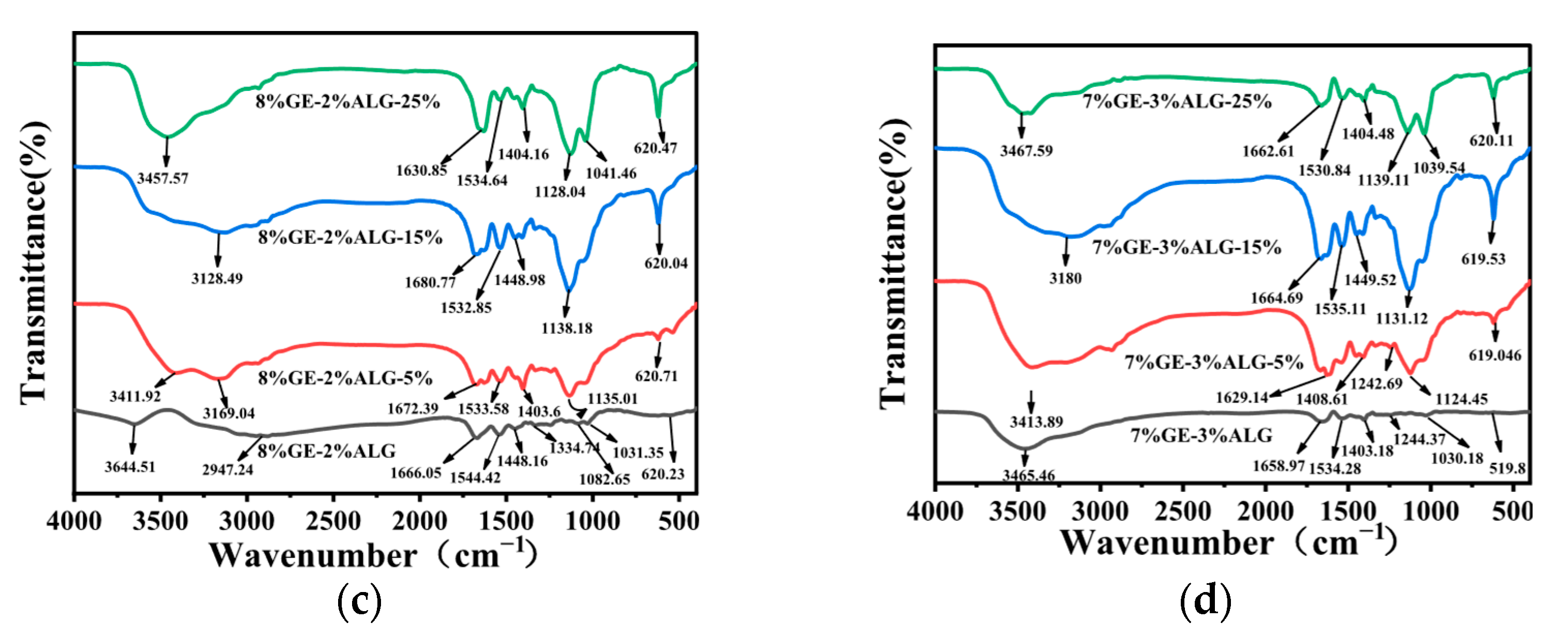
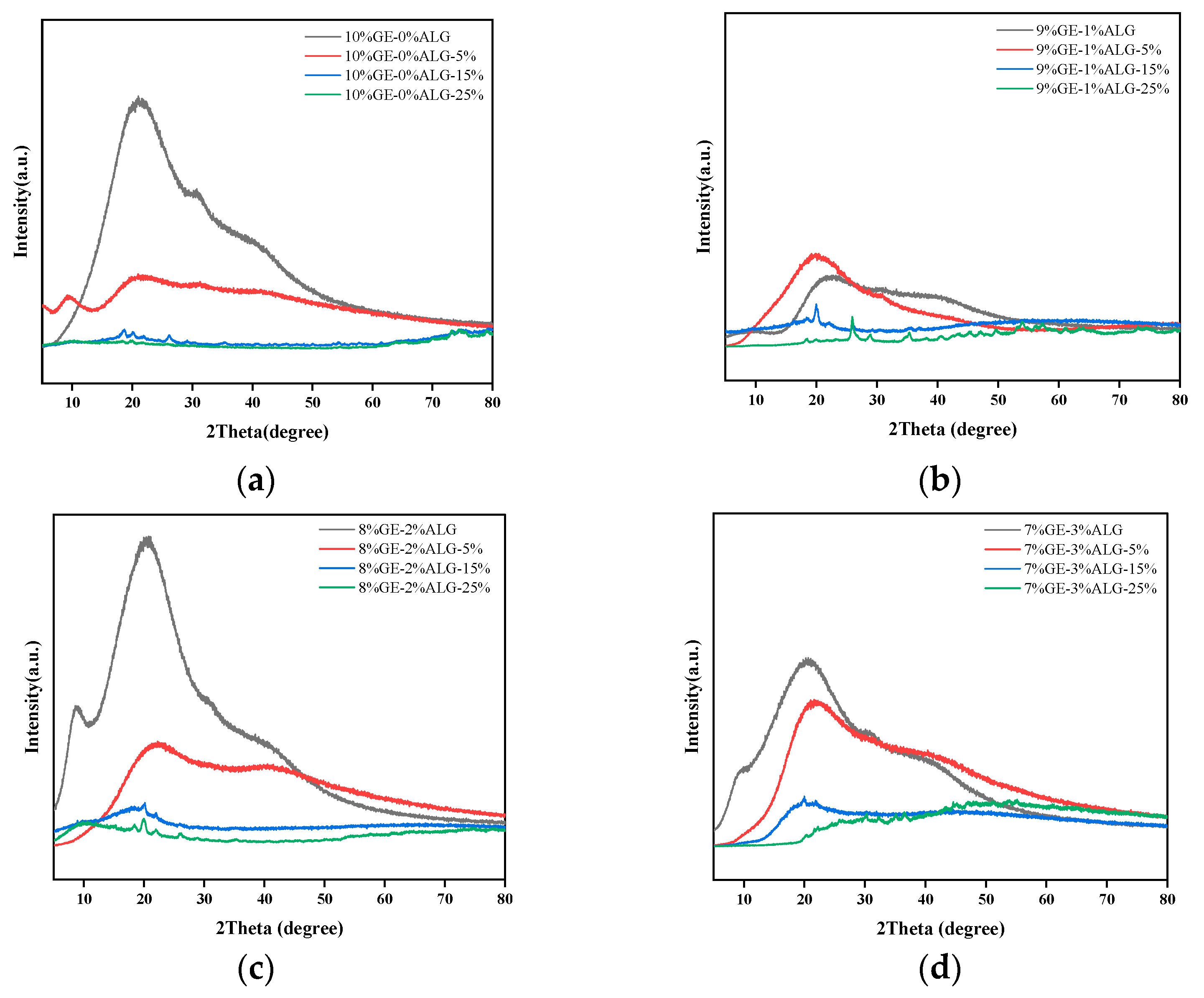
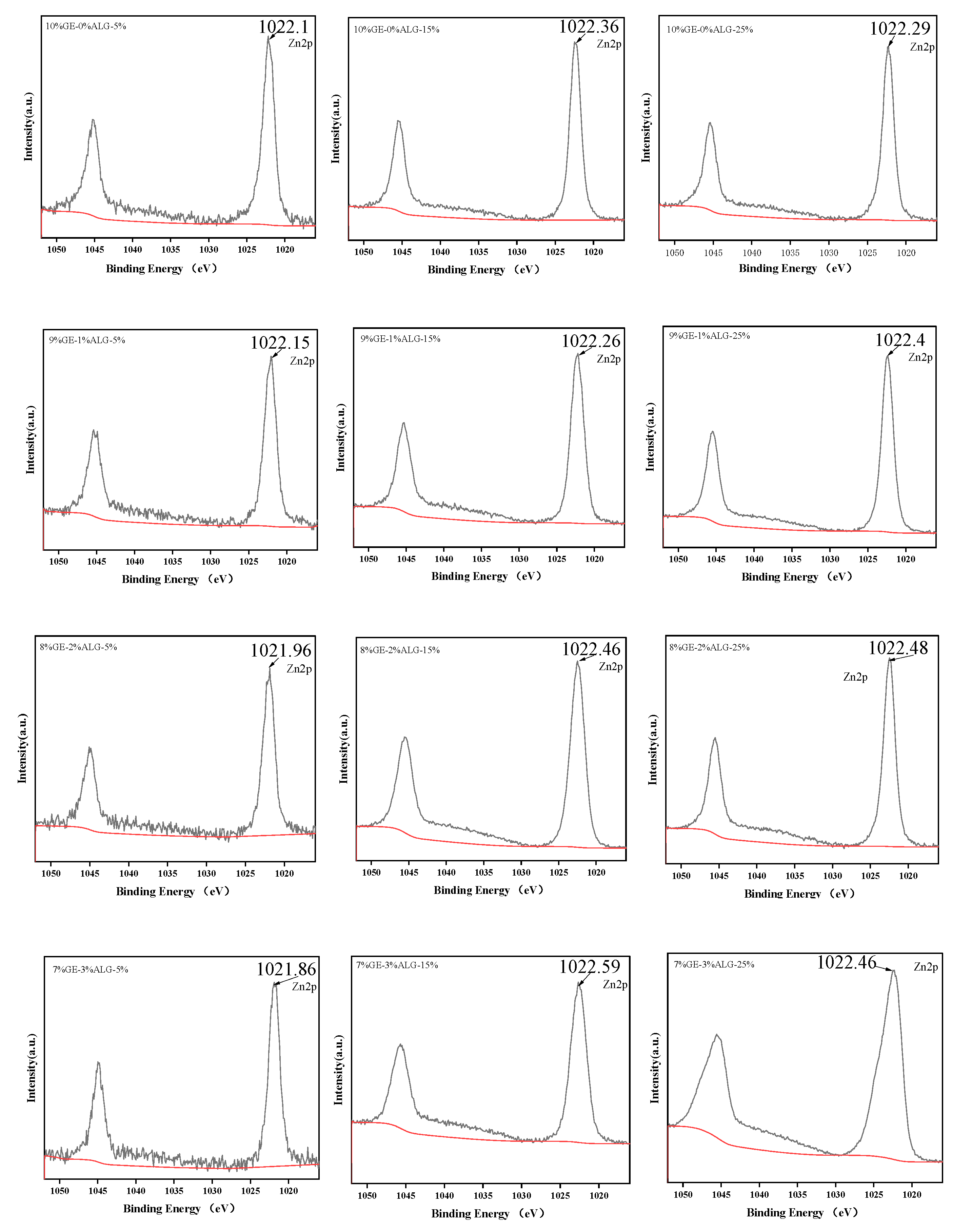
| Hydrogel Sample | GE (wt%) | ALG (wt%) | Zinc Sulfate Solutions (wt%) |
|---|---|---|---|
| 10%GE-0%ALG-5% | 10 | 0 | 5 |
| 10%GE-0%ALG-15% | 10 | 0 | 15 |
| 10%GE-0%ALG-25% | 10 | 0 | 25 |
| 9%GE-1%ALG-5% | 9 | 1 | 5 |
| 9%GE-1%ALG-15% | 9 | 1 | 15 |
| 9%GE-1%ALG-25% | 9 | 1 | 25 |
| 8%GE-2%ALG-5% | 8 | 2 | 5 |
| 8%GE-2%ALG-15% | 8 | 2 | 15 |
| 8%GE-2%ALG-25% | 8 | 2 | 25 |
| 7%GE-3%ALG-5% | 7 | 3 | 5 |
| 7%GE-3%ALG-15% | 7 | 3 | 15 |
| 7%GE-3%ALG-25% | 7 | 3 | 25 |
| Hydrogel Sample | Frequency (Hz) | Heating (°C) | Cooling (°C) |
|---|---|---|---|
| 10%GE-0%ALG-5% | 28 | 34.93 | 10.79 |
| 10%GE-0%ALG-15% | 29 | 36.41 | 15.26 |
| 10%GE-0%ALG-25% | 37.5 | 37.11 | 19.94 |
| 9%GE-1%ALG-5% | 51 | 37.87 | 12.23 |
| 9%GE-1%ALG-15% | 51.5 | 37.87 | 15.29 |
| 9%GE-1%ALG-25% | 50.5 | 41.52 | 21.55 |
| 8%GE-2%ALG-5% | 69.5 | 38.57 | 12.22 |
| 8%GE-2%ALG-15% | 59 | 38.57 | 16.83 |
| 8%GE-2%ALG-25% | 58.5 | 45.13 | 23.13 |
| 7%GE-3%ALG-5% | 47 | 38.58 | 12.24 |
| 7%GE-3%ALG-15% | 62 | 38.58 | 15.29 |
| 7%GE-3%ALG-25% | 57.5 | 42.96 | 21.55 |
Disclaimer/Publisher’s Note: The statements, opinions and data contained in all publications are solely those of the individual author(s) and contributor(s) and not of MDPI and/or the editor(s). MDPI and/or the editor(s) disclaim responsibility for any injury to people or property resulting from any ideas, methods, instructions or products referred to in the content. |
© 2025 by the authors. Licensee MDPI, Basel, Switzerland. This article is an open access article distributed under the terms and conditions of the Creative Commons Attribution (CC BY) license (https://creativecommons.org/licenses/by/4.0/).
Share and Cite
Chen, H.; Guan, X.; He, X.; Zhang, Q.; Zhang, X.; Chi, H.; Jiang, Z.; Tang, J. Gelatin-Based Zinc-Loaded Hydrogels Constructed with the Assistance of Sodium Alginate and Zinc Sulfate Solution Soaking Method. Foods 2025, 14, 3642. https://doi.org/10.3390/foods14213642
Chen H, Guan X, He X, Zhang Q, Zhang X, Chi H, Jiang Z, Tang J. Gelatin-Based Zinc-Loaded Hydrogels Constructed with the Assistance of Sodium Alginate and Zinc Sulfate Solution Soaking Method. Foods. 2025; 14(21):3642. https://doi.org/10.3390/foods14213642
Chicago/Turabian StyleChen, Hongrui, Xi Guan, Xianglin He, Qing Zhang, Xingzhong Zhang, Hai Chi, Zhenju Jiang, and Jie Tang. 2025. "Gelatin-Based Zinc-Loaded Hydrogels Constructed with the Assistance of Sodium Alginate and Zinc Sulfate Solution Soaking Method" Foods 14, no. 21: 3642. https://doi.org/10.3390/foods14213642
APA StyleChen, H., Guan, X., He, X., Zhang, Q., Zhang, X., Chi, H., Jiang, Z., & Tang, J. (2025). Gelatin-Based Zinc-Loaded Hydrogels Constructed with the Assistance of Sodium Alginate and Zinc Sulfate Solution Soaking Method. Foods, 14(21), 3642. https://doi.org/10.3390/foods14213642







